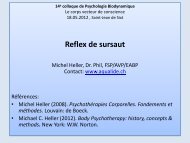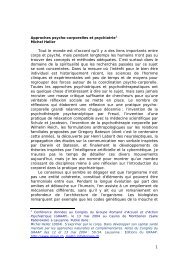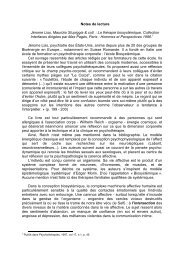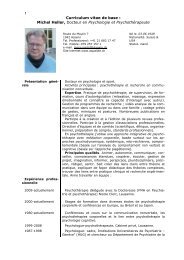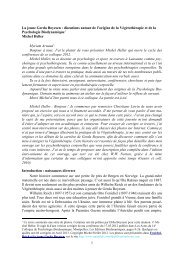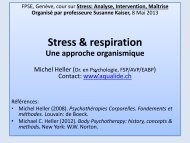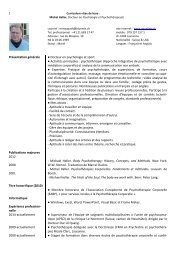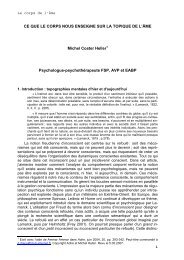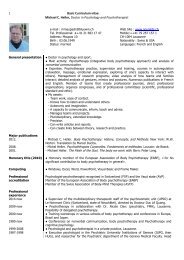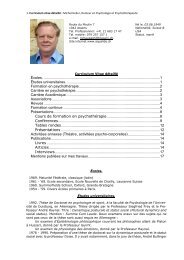Otto Fenichel & Wilhelm Reich: history of a friendship
Otto Fenichel & Wilhelm Reich: history of a friendship
Otto Fenichel & Wilhelm Reich: history of a friendship
Create successful ePaper yourself
Turn your PDF publications into a flip-book with our unique Google optimized e-Paper software.
VIENNA, 12 TH EABP CONGRESS<br />
<strong>Otto</strong> <strong>Fenichel</strong> & <strong>Wilhelm</strong> <strong>Reich</strong>:<br />
The father and the hidden uncle <strong>of</strong><br />
body psychotherapy (illustrations<br />
added in 2012)*<br />
BY<br />
MICHAEL COSTER HELLER, DR. PHIL<br />
PSYCHOLOGIST & PSYCHOTHERAPIST FSP/AVP/EABP<br />
RUE DU MAUPAS 10, CH-1004 LAUSANNE<br />
CONTACT AND ARTICLES: WWW.AQUALIDE.CH<br />
*A CHAPTER IN: Michael C. Heller (2012). Body Psychotherapy: <strong>history</strong>,<br />
concepts & methods. New York: W.W. Norton.
• Even if I summarize the data, the <strong>Reich</strong>-<strong>Fenichel</strong><br />
relationship yields so much crucial information<br />
that I may not have time to tell you all I would<br />
want to.<br />
• Instead <strong>of</strong> rushing you through more data than<br />
you can take, I will put my power point<br />
presentation on my website, next week, so that<br />
you can look at the information at a leisurely<br />
space.<br />
• I thank Johannes <strong>Reich</strong>mayr for some <strong>of</strong> the facts<br />
on <strong>Otto</strong> <strong>Fenichel</strong> contained in this presentation.<br />
• My website: www.aqualide.com
I. The beguining:<br />
Island near Bergan, in Norway, where Ola Raknes (1887-1975) and gerda<br />
Boyesen’s maternal grand mother were born (source: Ebba Boyesen)
• 1897: Birth <strong>of</strong> <strong>Wilhelm</strong> <strong>Reich</strong> in<br />
Galicia, which was the part <strong>of</strong><br />
Austrian Ukraine<br />
http://ukrainetrek.com/eastern-district<br />
10 years latter, birth <strong>of</strong><br />
<strong>Wilhelm</strong> <strong>Reich</strong> & <strong>Otto</strong> <strong>Fenichel</strong><br />
• 1897: Birth <strong>of</strong> <strong>Otto</strong> <strong>Fenichel</strong><br />
in Vienna, capital <strong>of</strong> the<br />
Austro-Hungarian Empire<br />
http://de.wikipedia.org/wiki/Datei:Altes_Rathaus_Wien_um_18<br />
80.gif
II. Vienna after the<br />
first world war:<br />
anti war youth<br />
movements fight<br />
for a responsible<br />
sexual freedom<br />
http://www.buecher-verkaufen.de/images/aiz-viii.jpg
• 1915: <strong>Otto</strong> <strong>Fenichel</strong><br />
enters the Faculty <strong>of</strong><br />
medicine in Vienna<br />
• 1916: <strong>Otto</strong> <strong>Fenichel</strong><br />
joins Jewish Marxist<br />
youth movement, who<br />
are fighting for a new<br />
way <strong>of</strong> dealing with<br />
sexual politics and<br />
morals.<br />
• 1916: <strong>Fenichel</strong> follows<br />
Freud’s conferences<br />
• 1915: <strong>Wilhelm</strong> <strong>Reich</strong><br />
is enrolled in the<br />
Austrian army<br />
• 1918: <strong>Wilhelm</strong> <strong>Reich</strong><br />
enters the Faculty <strong>of</strong><br />
medicine in Vienna.<br />
He is an emigrant<br />
from the periphery <strong>of</strong><br />
the empire.
1919-1921: <strong>Otto</strong> <strong>Fenichel</strong> creates the Seminar<br />
on sexology in the medical faculty<br />
• <strong>Otto</strong> <strong>Fenichel</strong> follows<br />
Freud’s conferences.<br />
http://t0.gstatic.com/images?q=tbn:ANd9GcT1lWVcGUrecHuCLvl5MFHzFPcZAOzxTYjKF2<br />
NCEF7BIS05w2hZ
1919-1921: <strong>Wilhelm</strong> <strong>Reich</strong> becomes a student in <strong>Otto</strong><br />
<strong>Fenichel</strong>’s seminar on sexology in the medical faculty<br />
http://www.google.ch/imgres?q=wilhelm+reich+images&num=10&hl=fr&client=firefoxa&rls=org.mozilla:fr:<strong>of</strong>ficial&biw=1152&bih=642&tbm=isch&tbnid=hLkCf3feYCCQOM:&imgrefurl=ht<br />
tp://clarte.eu.com/petiteperfection/theoscopie/articles/invitationaladansedusabre.htm&docid=zjIL<br />
RL0XcPkJmM&imgurl=http://clarte.eu.com/petiteperfection/theoscopie/articles/invitationaladanse<br />
dusabre/Wilhem.jpg&w=225&h=310&ei=UTreTovcMobYsgb8sdT5CA&zoom=1
What <strong>Wilhelm</strong> <strong>Reich</strong> discovered in<br />
<strong>Otto</strong> <strong>Fenichel</strong>’s sexual seminar:<br />
- Youth movements and sexual revolution<br />
- A humanist form <strong>of</strong> Marxism<br />
- Sexology<br />
- Freud<br />
- The psychoanalysis <strong>of</strong> Ferenczi<br />
EABP Congress, Vienna 2010
1919<br />
- Vienna is now the capital <strong>of</strong> the Austrian Republic. It<br />
remains one <strong>of</strong> the capitals <strong>of</strong> German culture (e.g. It is<br />
still the center <strong>of</strong> classical psychoanalysis, as Freud is in<br />
Vienna).<br />
- The German empire becomes the Weimar republic. It<br />
now becomes the only important German speaking<br />
country. Berlin is gradually becoming the capital <strong>of</strong><br />
German culture. (e.g. The Berlin Institute <strong>of</strong><br />
Psychoanalysis, directed by Karl Abraham, is becoming<br />
the center <strong>of</strong> new psychoanalytic developments)
- <strong>Otto</strong> <strong>Fenichel</strong> and <strong>Wilhelm</strong> <strong>Reich</strong> become members <strong>of</strong> the<br />
psychoanalytic Association, and the group <strong>of</strong> Marxist<br />
psychoanalysts, directed by Paul Federn.<br />
-They have their first patients.<br />
1920<br />
-They both follow a psychoanalysis with Paul Federn. <strong>Reich</strong> only<br />
receives a short treatment (a few months). <strong>Reich</strong> also has a short<br />
treatment with Isodor Isaak Sadger.<br />
- <strong>Fenichel</strong> introduces Annie Pink to <strong>Wilhelm</strong> <strong>Reich</strong>. She begins a<br />
psychoanalysis with <strong>Reich</strong>. She then becomes Annie <strong>Reich</strong>. They<br />
will have two children together: Eva (1924) and Lore (1928). Annie<br />
<strong>Reich</strong> also became a member <strong>of</strong> Marxist psychoanalysts. Her<br />
<strong>friendship</strong> with <strong>Fenichel</strong> lasted until his death.
The Communism <strong>of</strong> <strong>Fenichel</strong> and <strong>Reich</strong><br />
• <strong>Otto</strong> <strong>Fenichel</strong> belonged to<br />
the Austrian more socialist<br />
form <strong>of</strong> Marxism, close to<br />
Kautsky’s branch <strong>of</strong><br />
communism, which<br />
remained close to Marx’s<br />
notion that communism<br />
should influence historical<br />
processes through<br />
democratic procedures.<br />
• <strong>Wilhelm</strong> <strong>Reich</strong> belonged<br />
to the soviet Leninist<br />
branch <strong>of</strong> communism,<br />
which believed that<br />
communists should take<br />
power through a<br />
revolution.<br />
Among Marxist psychoanalysts, the socialist branch was<br />
dominant. <strong>Reich</strong> wanted to convert them to his point <strong>of</strong><br />
view.
The context<br />
• Freud looks for new trainers who can teach his second<br />
topography (id, ego, super-ego). <strong>Fenichel</strong> and <strong>Reich</strong> are ideal<br />
persons for this task.<br />
Psychoanalytic A-<br />
Team, 1922. Seated,<br />
left to right, Freud,<br />
Ferenczi, and Hans<br />
Sachs; standing, <strong>Otto</strong><br />
Rank, Karl Abraham,<br />
Max Eitingon, and<br />
Ernest Jones<br />
http://search.babylon.com/imageres.php?iu=http://pointsadhsblog.files.wordpress.com/2011/07/freud_and_other_psychoanalysts_19221.jpg&ir=http://pointsadhsblog.wordpress.co<br />
m/2011/07/21/e-m-jellinek%E2%80%99s-essay-on-drinking%E2%80%99s-symbolism-anotherlook/&ig=http://t0.gstatic.com/images?q=tbn:ANd9GcSh5JPVdQ9H8A9gEeZ_2ar4W7fqfKJAP0ehkrqVEA_i6fxx5vIoIoC4Wlcb&h=459&w=640&q=ferenczi&babsrc=SP_ss
1922-1923: Berlin, I<br />
- <strong>Fenichel</strong> asked <strong>Reich</strong> to direct the sexual seminar and<br />
left for Berlin.<br />
- There, Karl Abraham and his colleague had created a<br />
Berlin Psychoanalytic Institute <strong>of</strong> psychoanalysis. After<br />
the war, Vienna was only the capital <strong>of</strong> psychoanalysis<br />
because Freud lived there… a bit like Washington is the<br />
capital <strong>of</strong> the USA. The New York <strong>of</strong> psychoanalysis had<br />
moved to Berlin. This where the new development were<br />
forged. This is where psychoanalysts developed the<br />
implications <strong>of</strong> Freud’s Second Topography (Id, Ego &<br />
Super-Ego) and the dynamics <strong>of</strong> transference.
1922-1923: Berlin, II<br />
The institute <strong>of</strong>fers the first serious training for<br />
psychoanalysis. It requires an in depth psychoanalysis<br />
and regular supervision. In Vienna this was not proposed<br />
because Freud did not want to be the therapist <strong>of</strong> all his<br />
colleagues. He wanted collegial relationships. In Berlin<br />
there was enough eminent psychoanalysts to carry out<br />
such a training program.
Abraham also created a psychoanalytic<br />
clinic for people who needed support from<br />
psychoanalysts but who cannot afford a<br />
classical psychoanalytic cure.<br />
Each person who wanted to become a<br />
psychoanalyst had to follow one patient<br />
for one year without pay, or support the<br />
clinic by paying 4% <strong>of</strong> what he earned in<br />
his private practice. By working at the<br />
clinic a young psychoanalyst could have<br />
practical supervised experience.<br />
http://ecx.images-amazon.com/images/I/51IbOz-l-FL._BO2,204,203,200_PIsitb-sticker-arrow-click,TopRight,35,-<br />
76_AA300_SH20_OU01_.jpg
1922-1923: Berlin, III<br />
Most <strong>of</strong> the famous psychoanalysts <strong>of</strong> that<br />
generation are there. For example: Erich Fromm,<br />
Karen Horney, Edith Jacobson from Germany,<br />
Melanie Klein et Helene Deutsch from Austria,<br />
Edward et James Glover from England, Sándor<br />
Radó et Franz Alexander from Hungary, Nic Waal<br />
et Ola Raknes from Norway, and Trygve Braatøy<br />
from the USA.<br />
Most <strong>of</strong> you have read at least one <strong>of</strong> these<br />
psychoanalysts.
<strong>Fenichel</strong> and Gindlerian gymnastics (1925-1940), I<br />
In Berlin, <strong>Otto</strong> <strong>Fenichel</strong> fell in love with Clare<br />
Nathansohn. She soon became Clare <strong>Fenichel</strong>. They gave<br />
birth to a daughter called Hanna. This Hanna is not the<br />
same Hanna who became <strong>Fenichel</strong>’s second wife, in<br />
California.<br />
The reason why we need to include this marriage in our<br />
discussion is that Clare <strong>Fenichel</strong> was also a teacher in<br />
gymnastics, trained by Elsa Gindler, who was presented<br />
to you this morning by Ulf Geuter.
Elsa Gindler<br />
• http://t3.gstatic.com/images?q=tbn:ANd9GcTOSaP8Y51-l07HDpVBMbFhZk9vd-MLUXDyruw-pgeT4wABmtMeKQ
Elsa Gindler<br />
• http://search.babylon.com/imageres.php?iu=http://dc426.4shared.com/doc/KaqRfSkZ/preview007.png&ir=http://dc426.4shared.com/doc/KaqRfSkZ/preview.html&<br />
ig=http://t0.gstatic.com/images?q=tbn:ANd9GcRRK7x1ERYsbfIQlVkyOWLa0p4xw56GsRA0RHGFQ7wImGfQeT3JwN48maWC&h=1516&w=1073&q=elsa+gindler&babsr<br />
c=SP_ss
<strong>Fenichel</strong> and Gindlerian gymnastics (1925-1940), II<br />
- <strong>Otto</strong> <strong>Fenichel</strong> followed Elsa Gindler’s school,<br />
where he discovered body work. There he got rid<br />
<strong>of</strong> his migraines which nobody, including his<br />
psychotherapists, could cure.<br />
- As we shall see in Johannes <strong>Reich</strong>mayr’s<br />
presentation, <strong>Fenichel</strong> began to imagine that one<br />
could use gymnastics and psychoanalysis as<br />
complementary modes <strong>of</strong> intervention for certain<br />
person’s.
<strong>Fenichel</strong> and Gindlerian gymnastics (1925-1940),<br />
III<br />
To integrate gymnastics into psychoanalysis, <strong>Fenichel</strong><br />
developed the following formulation the relation<br />
between Ego and motor functions imagined by Freud:<br />
« The ego is first and foremost a body-ego, » says<br />
Freud in The Ego and the Id, and he means by this<br />
that the distinction between ego-and non-ego is<br />
first learned by the infant in the discovery <strong>of</strong> its<br />
body in such a way that in its world <strong>of</strong> ideas its<br />
own body begins to be set <strong>of</strong>f from the rest <strong>of</strong> the<br />
environment. (<strong>Otto</strong> <strong>Fenichel</strong> 1938, The drive to<br />
amass wealth: 97)
<strong>Fenichel</strong> and Gindlerian gymnastics (1925-1940), IV<br />
- He developed a model in which the libido coordinated<br />
the mental, physiological and body dimensions. In this<br />
model all these dimensions continuously influenced<br />
each other.<br />
- What psychoanalysts called resistances structured the<br />
following dimensions: Ways <strong>of</strong> thinking, instinctual<br />
dynamics, muscular tone (hypertone and hypotone),<br />
breathing, metabolism, and the texture <strong>of</strong> the skin.<br />
- Each <strong>of</strong> these dimensions allowed the therapist to<br />
contact specific dimensions <strong>of</strong> emotional and<br />
psychological dynamics.
<strong>Fenichel</strong> and Gindlerian gymnastics (1925-1940), V<br />
- <strong>Otto</strong> and Clare <strong>Fenichel</strong> organized seminars in the<br />
psychoanalytic institute, on psychoanalysis,<br />
gymnastics and breathing.<br />
- In 1928 <strong>Fenichel</strong> published an article on organ<br />
Libidinization, in which he described how gymnastics<br />
and psychoanalysis could be used as complementary<br />
modes <strong>of</strong> intervention to explore the dynamics <strong>of</strong> the<br />
emotions and <strong>of</strong> the mind. For him body and mind<br />
function in clearly differentiated ways, that<br />
nevertheless interact with each other within the<br />
organism.
<strong>Fenichel</strong> and Gindlerian gymnastics (1925-1940), VI<br />
- Because body and mind do not function in the same<br />
way, they need to be approached through different<br />
methods. This was at least the vision <strong>Otto</strong> fenichel<br />
and Elsa Gindler, who never tried to combine their<br />
methods with a single process, but who sometimes<br />
recommended to a patient that he could follow both<br />
forms <strong>of</strong> treatment in parallel.<br />
- Here is an example:
<strong>Fenichel</strong> and Gindlerian gymnastics (1925-1940), VII<br />
A patient reported that her gymnastics teacher<br />
continually called her attention to the intensity with<br />
which she kept her neck and throat musculature in a<br />
constant spastic tension. Attempts to loosen this tension<br />
only increased it. The analysis showed that as a child the<br />
patient saw a pigeon’s head being torn <strong>of</strong>f and the<br />
headless pigeon still moving its wings a few times. This<br />
experience lent her castration complex a lasting form:<br />
she had an unconscious fear <strong>of</strong> being behaded, and this<br />
fear also manifested itself in numerous other symptoms,<br />
modes <strong>of</strong> behavior, and directions <strong>of</strong> interest. (<strong>Otto</strong><br />
<strong>Fenichel</strong>, Organ Libidinization, I: 133)
<strong>Fenichel</strong> and Gindlerian gymnastics (1925-1940), VIII<br />
In this example it is the gymnastic teacher who<br />
isolates a body phenomenon that should be explored by<br />
the psychoanalyst. The psychoanalyst discovers what<br />
unconscious situation is related to that body<br />
phenomenon. He also discovers that transference<br />
prevented the gymnastic teacher from being efficient.<br />
The patient identified herself with the pigeon and the<br />
gymnastic teacher to the force that cut the pigeon’s<br />
head.<br />
In other cases, as with <strong>Fenichel</strong>’s headaches, it is the<br />
gymnastic teacher that holds the relevant handle to<br />
explore a symptom, not the psychoanalyst.
• It is probably in the context <strong>of</strong> these discussions<br />
that Berliner analysts became interested in<br />
psychosomatics. The most famous <strong>of</strong> these was<br />
Franz Alexander, who later, in the USA, like<br />
<strong>Fenichel</strong>, also integrated Cannon’s organismic<br />
model <strong>of</strong> homeostasis.<br />
•<br />
• This is the nest in which <strong>Reich</strong> developed in own<br />
form <strong>of</strong> integration <strong>of</strong> body and mind dynamics in<br />
the organism. The theme <strong>of</strong> body and<br />
psychoanalysis was a hot issue for several<br />
members <strong>of</strong> the Berlin Institute. <strong>Reich</strong> brought<br />
many creative issues into this discussion.
<strong>Reich</strong> in Vienna (1920-1930), I<br />
In Vienna <strong>Reich</strong> developed the following themes:<br />
1. The libido generates stasis when it cannot express<br />
itself through orgasm. It will then generate neurosis<br />
as described in Freud’s model. Orgasm is a basic<br />
reference model <strong>of</strong> how all the dimensions <strong>of</strong> two<br />
organisms can interact with each other in a<br />
constructive and synergic way.<br />
2. <strong>Reich</strong> participates in the creation <strong>of</strong> a Viennese clinic<br />
which more or less worked like the Berlin clinic. There<br />
he studied the sexual behavior <strong>of</strong> people.<br />
3. He directed a training seminar where supervision <strong>of</strong><br />
young psychoanalysts was used to improve their<br />
technique. It is in this context that he created his first<br />
model <strong>of</strong> Character Analysis.
<strong>Reich</strong> in Vienna (1920-1930), II: Organismic approach<br />
- <strong>Reich</strong> became interested in the biological concept <strong>of</strong><br />
the organism, on the organism as an individual<br />
organism capable <strong>of</strong> self regulation while it interacted<br />
with is environment. This notion was fashionable in<br />
many intellectual circles in these days.<br />
- This individual system has its own particular biological<br />
or life energy, which forces biological organisms to<br />
evolve and look for increasingly efficient and<br />
functional modes <strong>of</strong> functioning.<br />
- For the moment he does not know what to do with<br />
this interest.
<strong>Reich</strong> in Vienna (1920-1930), III: psychoanalytic<br />
Character Analysis<br />
- The psychoanalytic Character Analysis focused on<br />
behavior and non verbal communication to contact the<br />
emotions that are associated to representations in the<br />
mind.<br />
- When I use the term body, I used it in its most restricted<br />
sense, referring to posture and muscular tone, as in<br />
Gindler’s gymnastics. This type <strong>of</strong> body work does not<br />
yet exist in <strong>Reich</strong>’s thinking, except, sometimes, when he<br />
speaks <strong>of</strong> sexual behavior and physiological arousal.
V. 1930, <strong>Reich</strong> in Berlin (1930-1933)<br />
http://search.babylon.com/imageres.php?iu=http://www.logosjournal.com/issue_7.1/images/reich295Wx250H.jpg&ir=http://www.logosjournal.com/issue_7.1/nitzschke.htm<br />
&ig=http://t2.gstatic.com/images?q=tbn:ANd9GcRjdaXOhdVxVJz1T_3iMczlxWvqbZ901WT2qZfvNlaNhOCWwkNUTH4FsKs&h=250&w=295&q=berlin+1930+sexpol&babsrc=SP_ss
The discovery <strong>of</strong> <strong>Fenichel</strong>’s body<br />
In 1930, the <strong>Reich</strong>’s move to Berlin.<br />
There they are welcomed by the<br />
<strong>Fenichel</strong>’s. <strong>Reich</strong> is presented to every<br />
one not only as a close collaborator <strong>of</strong><br />
Freud, but as <strong>Otto</strong> <strong>Fenichel</strong>’s best friend.<br />
- Annie and Eva <strong>Reich</strong> follow courses <strong>of</strong><br />
Gindlerian gymnastic with Clare<br />
<strong>Fenichel</strong>. They seem to love it and speak<br />
<strong>of</strong> it to <strong>Wilhelm</strong> <strong>Reich</strong>. Annie and Eva<br />
<strong>Reich</strong> (6 years old) are thus those who<br />
introduced body work to <strong>Reich</strong>.<br />
http://t3.gstatic.com/images?q=tbn:ANd9GcQ815tH5eXsGG0wtGwklde4QfpVae7nrxjTaU6TGkXZ0P_xqkK9N2qDfKA
<strong>Wilhelm</strong> <strong>Reich</strong> falls in love with Elsa Lindenberg. She is a ballet<br />
dancer who was trained by, among others, Rudolph Laban, who is still<br />
very influential in dance therapy and a reference in studies <strong>of</strong><br />
nonverbal communication.<br />
http://a4.ecimages.myspacecdn.com/images02/87/6d2014907b8f4593b481<br />
54f0a9549cbd/l.jpg<br />
<strong>Reich</strong> et Lindenberg<br />
http://www.google.ch/imgres?q=elsa+lindenberg+images&hl=fr&client=firefoxa&rls=org.mozilla:fr:<strong>of</strong>ficial&biw=1152&bih=642&tbm=isch&tbnid=dW5GmVTCLwhJPM:&imgrefurl=http://heyo<br />
kamagazine.com/HEYOKA.3.WILHELM%2520REICH.htm&docid=J4jXbIcF47iVWM&imgurl=http://heyokamagazin<br />
e.com/wr-und-eva-amstrand.jpg&w=498&h=320&ei=Mj_eTtadItGJhQeG8IzqBA&zoom=1&iact=rc&dur=260&sig=117036279167446822<br />
923&page=1&tbnh=131&tbnw=174&start=0&ndsp=22&ved=1t:429,r:1,s:0&tx=108&ty=95
http://t0.gstatic.com/images?q=tbn:ANd9GcQhS1DwAo03lZ-<br />
FxUsZB9BLDq1gAhpnjhr6qDpl2_U7e63RfGyjLKYzW3Dk<br />
Laban
Laban in Berlin and Monte Verita<br />
http://img3.photographersdirect.com/img/262/wm/pd535443.jpg<br />
http://www.laban-holiday-courses.org/Monte-Verita-Laban-0.jpg
Laban<br />
Bundesarchiv Bild 102-09847, Tanzschule Laban im Strandbad Wannsee.jpg<br />
http://upload.wikimedia.org/wikipedia/commons/0/0b/Bundesarchiv_Bild_102-09847%2C_Tanzschule_Laban_im_Strandbad_Wannsee.jpg
Laban<br />
Bundesarchiv Bild 102-09847, Tanzschule Laban im Strandbad Wannsee.jpg<br />
http://upload.wikimedia.org/wikipedia/commons/f/f7/Bundesarchiv_Bild_102-09849%2C_Tanzschule_Laban_im_Strandbad_Wannsee.jpg
<strong>Reich</strong> in Berlin (1930-1933): The discovery <strong>of</strong> <strong>Fenichel</strong>’s<br />
body, II<br />
- It is during this period that <strong>Reich</strong> slowly but<br />
surely begins to include interventions on the<br />
body, using message and breathing techniques,<br />
during his sessions. It is therefore, once again<br />
clearly under the influence <strong>of</strong> <strong>Fenichel</strong> that<br />
<strong>Reich</strong> began to combine body work within the<br />
same sessions.
<strong>Reich</strong> in Berlin (1930-1933): The discovery <strong>of</strong> <strong>Fenichel</strong>’s<br />
body, II<br />
- We thus have two forms <strong>of</strong> psychoanalytical<br />
body psychotherapy by 1933:<br />
- 1. The <strong>Fenichel</strong>-Gindler way <strong>of</strong> associating a body<br />
work that is sensitive to the mind (Gindler’s<br />
gymnastics) and an approach <strong>of</strong> the mind that is<br />
sensitive to body dynamics (<strong>Fenichel</strong>’s approach).<br />
- 2. The <strong>Reich</strong>ian method which includes highly<br />
simplistic body techniques in a psychoanalytic<br />
treatment.
The crisis : 1933 – 1935, I<br />
- History now intrudes it what was a smooth<br />
story, with the following events:<br />
- <strong>Reich</strong> is also an important member <strong>of</strong> the<br />
German Communist Party and <strong>of</strong> the<br />
communist youths. He is also involved in his<br />
sexual revolution project, in which he wants to<br />
include new sexual politics, based on<br />
institutional and political reforms-<br />
- Hitler is elected, promoting war on<br />
Communism and Jews alike.
The crisis : 1933 – 1935, II<br />
- For political reasons he is simultaneously, within a<br />
year, thrown out <strong>of</strong> :<br />
- 1. Fascist Germany, because he is a communist and a Jew.<br />
- 2. The communist party because in The Mass Psychology <strong>of</strong><br />
Fascism <strong>Reich</strong> criticizes the communist party in ways that are<br />
incompatible with the rising Stalinism.<br />
- 3. The German Association <strong>of</strong> Psychoanalysis, who wants to be<br />
able to survive in Nazi Germany. Technically <strong>Reich</strong> could have<br />
been recognized as a psychoanalyst again by enlisting in the<br />
Norwegian psychoanalytic association. This solution was<br />
supported by <strong>Otto</strong> <strong>Fenichel</strong>.
The crisis : <strong>Reich</strong> abandons psychotherapy and creates<br />
organismic therapy<br />
- When Adler, Jung and Lacan where kicked out <strong>of</strong> the<br />
International Psychoanalytic Association, they<br />
developed their kind <strong>of</strong> psychoanalysis, without being<br />
able to really compete with the popularity <strong>of</strong> Freud’s<br />
psychoanalysis.<br />
- <strong>Reich</strong> did not want to finish his career as an ersatz<br />
psychoanalyst. He remembered his old passion for<br />
organismic theories, and decided to create a new<br />
form <strong>of</strong> therapy which focused on the global<br />
regulation systems <strong>of</strong> the organism.
IV. Oslo (1934-1939)<br />
http://upload.wikimedia.org/wikipedia/commons/thumb/0/0c/Oslo_harbour_colors_modified.jpg/800px-Oslo_harbour_colors_modified.jpg
The house <strong>of</strong> Elsa and <strong>Wilhelm</strong> in Oslo<br />
http://www.google.ch/imgres?q=wilhelm+reich+images&num=10&hl=fr&client=firefoxa&rls=org.mozilla:fr:<strong>of</strong>ficial&biw=1152&bih=642&tbm=isch&tbnid=GGurPGAPwjMQaM:&imgrefurl=http://tree<strong>of</strong>lifetech.net/scientific-contributions/blankenship-reichdinhaw/&docid=As9zuPmNLWeknM&imgurl=http://tree<strong>of</strong>lifetech.net/wpcontent/uploads/2011/01/<strong>Wilhelm</strong><strong>Reich</strong>.jpg&w=256&h=276&ei=UTreTovcMobYsgb8sdT5CA&zoom=1<br />
http://upload.wikimedia.org/wikipedia/commons/thumb/2/27/<strong>Wilhelm</strong>_<strong>Reich</strong>%27s_home.jpg/250px-<strong>Wilhelm</strong>_<strong>Reich</strong>%27s_home.jpg<br />
http://t0.gstatic.com/images?q=tbn:ANd9GcQhS1DwAo03lZ-FxUsZB9BLDq1gAhpnjhr6qDpl2_U7e63RfGyjLKYzW3Dk
<strong>Fenichel</strong> & Braatøy<br />
http://t2.gstatic.com/images?q=tbn:ANd9GcQ5wDvmvB4fxxTYCsPTkbfo5u1OJ0jJj_eG6dUwPN-QB9_jqduBM79jXiM<br />
http://www.google.ch/imgres?q=trygve+Braatoy+images&hl=fr&client=firefoxa&rls=org.mozilla:fr:<strong>of</strong>ficial&biw=1152&bih=642&tbm=isch&tbnid=cJDTLQ5QUwf_6M:&imgrefurl=http://tidsskriftet.no/article/1044083&docid=obsDEKqigiSLLM&imgurl=http://tidsskriftet.n<br />
o/lts-img/2004/L04-13-Pro-Kro-Meland-02.jpg&w=200&h=261&ei=0j7eTuT-KIXPhAfKmuz-BA&zoom=1
<strong>Reich</strong> & Raknes<br />
http://t0.gstatic.com/images?q=tbn:ANd9GcT5g9lUdT1C8ML6nBoUz4o5FcdgUA6tkdkQ6UpvILe62Q0M2JhvGSDf0d78<br />
http://t2.gstatic.com/images?q=tbn:ANd9GcSR3J5CIlwHMWoxUzoLFyy49uUWUeiiyFoQOMbAfsJssP9v9ZAqFA
The crisis : <strong>Reich</strong> abandons psychotherapy and creates<br />
organismic therapy<br />
- <strong>Reich</strong> turned his back on psychotherapy and<br />
communism, leaving these domains to psychoanalysts<br />
such as <strong>Otto</strong> <strong>Fenichel</strong> and Annie <strong>Reich</strong>.<br />
- It is in this context that he created Vegetotherapy, and<br />
ways <strong>of</strong> studying the energy <strong>of</strong> life that had fascinated<br />
him during his youth.<br />
- At the same time <strong>Reich</strong>’s seems to be so deeply<br />
wounded that he becomes bitter and hostile with all<br />
those that had been his friends. These worried for his<br />
mental equilibrium. It was the case for <strong>Otto</strong> <strong>Fenichel</strong><br />
and Annie <strong>Reich</strong>.
Vegetotherapy: I<br />
- Henceforth, the psychological and body dimensions<br />
only interested him as ways <strong>of</strong> influencing the global<br />
regulation systems <strong>of</strong> the body. He had no intention <strong>of</strong><br />
creating a body psychotherapy, for two reasons:<br />
- 1. He agreed with <strong>Fenichel</strong> and Gindler that one cannot not<br />
work simultaneously on dimensions such as the mind and the<br />
body, which follow completely different procedures.<br />
- 2. He was interested on the mechanisms that coordinate and<br />
structure the mind and the body.<br />
- What interested <strong>Reich</strong> was to heal the organism by<br />
working on the mechanisms that generate thoughts,<br />
behavior and body dynamics. Such work would allow<br />
him to cure whatever occurred in these dimensions.
1935 : <strong>Fenichel</strong>’s Theory <strong>of</strong> psychoanalytic technique<br />
- When <strong>Fenichel</strong> wrote this article, he still believed that<br />
one could openly discuss with <strong>Wilhelm</strong> <strong>Reich</strong> on his<br />
Vegetotherapy.<br />
- This discussion summarizes points that have recently<br />
been taken up by many body psychotherapist (E.G.,<br />
Peter Levine, Pat Ogden, etc.). <strong>Fenichel</strong> clearly saw<br />
what was problematic in <strong>Reich</strong>’s approaches. What he<br />
did not realize, is that <strong>Reich</strong> did not bother to remain<br />
compatible with notions that characterize<br />
psychotherapy in general.<br />
- This discussion only takes into considerations issues<br />
related to psychotherapy, and does not take into<br />
consideration <strong>Reich</strong>’s argumentation on energy.
1935 : <strong>Fenichel</strong>’s Theory <strong>of</strong> psychoanalytic<br />
technique: <strong>Fenichel</strong> agrees with <strong>Reich</strong> General<br />
Theory<br />
- <strong>Fenichel</strong> still believes that <strong>Wilhelm</strong> <strong>Reich</strong> is<br />
one <strong>of</strong> the best psychoanalyst alive.<br />
- <strong>Fenichel</strong> agrees with <strong>Reich</strong>’s general<br />
proposition, that body dynamics and<br />
psychological dynamics are dimensions <strong>of</strong><br />
the organism.<br />
- <strong>Fenichel</strong> agrees with <strong>Reich</strong>’s that the<br />
vegetative dimension <strong>of</strong> the organism plays<br />
a crucial role in affect regulation.
1935 : <strong>Fenichel</strong>’s Theory <strong>of</strong> psychoanalytic<br />
technique: <strong>Fenichel</strong> disagrees with some<br />
aspects <strong>of</strong> <strong>Reich</strong>’s therapeutic techniques, I<br />
- In the Vegetotherapy model, <strong>Reich</strong> proposes an<br />
analysis <strong>of</strong> the organisms in 7 segments. <strong>Fenichel</strong><br />
is not convinced that the human organism has an<br />
organization that is as well organized as <strong>Reich</strong>’s<br />
theory on the organism.<br />
- For <strong>Fenichel</strong>, <strong>Reich</strong>’s general conception has<br />
already been accepted by many. He can therefore<br />
leave simplifications aside, an include more<br />
complexity in his thinking. <strong>Fenichel</strong>’s approach to<br />
the body is, for example, better informed (through<br />
Gindler) than what <strong>Reich</strong> is willing to learn.
1935 : <strong>Fenichel</strong>’s Theory <strong>of</strong> psychoanalytic<br />
technique: <strong>Fenichel</strong> disagrees with some<br />
aspects <strong>of</strong> <strong>Reich</strong>’s therapeutic techniques, II<br />
- It seems to <strong>Fenichel</strong> that <strong>Reich</strong> believes that a<br />
defense system should be attacked, and that<br />
patients should learn to live without one.<br />
- For <strong>Fenichel</strong>, the defense system is the regulation<br />
<strong>of</strong> the mind. Wanting to destroy the defense<br />
system <strong>of</strong> a patient is as stupid as wanting to<br />
destroy is physiological immune system. He thus<br />
finds <strong>Reich</strong> recent way <strong>of</strong> working intrusive and<br />
dangerous.<br />
- If <strong>Reich</strong> could change this, it would enhance his<br />
technique, without requiring any change <strong>of</strong> <strong>Reich</strong>’s<br />
general theory.
1935 : <strong>Fenichel</strong>’s Theory <strong>of</strong> psychoanalytic<br />
technique: <strong>Fenichel</strong> disagrees with some<br />
aspects <strong>of</strong> <strong>Reich</strong>’s therapeutic techniques, III<br />
- The article contains several such critics which still<br />
remain valid today. They are integrated in several<br />
schools <strong>of</strong> body psychotherapy, as they were<br />
passed on by some <strong>of</strong> <strong>Fenichel</strong>’s pupils, like Trygve<br />
Braatøy in Oslo, and Laura Perls in Esalen<br />
(California). Those that use this analysis today<br />
usually do not know that these ideas initially came<br />
from <strong>Fenichel</strong>, yet his writings prove that this is<br />
the case.<br />
- <strong>Reich</strong> took this discussion as a personal insult and<br />
as a pro<strong>of</strong> that <strong>Fenichel</strong> wanted to destroy him;<br />
while <strong>Fenichel</strong> just wanted to engage in a<br />
discussion on psychotherapeutic technique with<br />
some one he loved and admired.
1935 : <strong>Fenichel</strong> goes to Prague, <strong>Reich</strong> turns to<br />
vinegar<br />
- In 1935 <strong>Fenichel</strong>s group <strong>of</strong> Marxist<br />
psychoanalysts, which includes Annie <strong>Reich</strong>, meet<br />
in Prague. Their aim is to save their friend and<br />
colleague Edith Jacobson, who was imprisoned by<br />
the Nazi Germans. Edith Jacobson is also an<br />
acquaintance <strong>of</strong> <strong>Reich</strong>. <strong>Fenichel</strong> & Co. manage to<br />
save Edith Jacobson. They than went to America.<br />
- <strong>Reich</strong> has mean while become such an angry,<br />
bitter and hostile person, that the only thing he<br />
can think <strong>of</strong> is his ambitions. He doses not seem<br />
to have the least interest for what happens to<br />
Edith Jacobson. Only he is the victim <strong>of</strong> historical<br />
circumstances.
1935 : <strong>Fenichel</strong> goes to Prague, <strong>Reich</strong> turns to<br />
vinegar<br />
-All <strong>Reich</strong> can say about this episode is that<br />
all the Norwegian colleagues loved his new<br />
proposals, and found <strong>Fenichel</strong> boring. That<br />
<strong>Fenichel</strong> had used Edith Jacobson as a<br />
pretext, so as not show that he had been<br />
defeated by <strong>Reich</strong>.<br />
- He now presents <strong>Fenichel</strong> as somebody who<br />
became a Marxist thanks to <strong>Reich</strong>, and whose<br />
theory is mainly based on <strong>Reich</strong>’s ideas (Oslo,<br />
16.12.1934). From then on <strong>Fenichel</strong> was<br />
presented by <strong>Reich</strong> as an ancient student who<br />
had become a Judas.
<strong>Fenichel</strong> dies in 1945, I<br />
• In Los Angeles, where he lived, <strong>Fenichel</strong><br />
published The psychoanalytic Theory <strong>of</strong><br />
neurosis, which is his testament. In it he shows<br />
that his interest for organismic processes is<br />
only one chapter, but an important chapter.<br />
This article states all the issues which, even<br />
today, body psychotherapists should be aware<br />
<strong>of</strong> when they work with the body in the spirit<br />
<strong>of</strong> a psychodynamic body psychotherapy.
<strong>Fenichel</strong> dies in 1945, II<br />
• He shows that one needs psychoanalytic work for<br />
the psyche and refined body work for the body.<br />
For him, <strong>Reich</strong>’s approach has become<br />
dangerous, because it lacks respect for defense<br />
systems and the chore self. This model is<br />
relatively close to today’s models <strong>of</strong> body<br />
psychotherapy inspired by the neurosciences.<br />
• Meanwhile <strong>Reich</strong> has advanced in his orgonomy,<br />
and now regularly combines body and<br />
psychological work in a global organismic model.
1945 : <strong>Reich</strong> on <strong>Fenichel</strong>’s death<br />
That man died <strong>of</strong> his structural cowardice, I cannot judge whether<br />
my publication <strong>of</strong> his misdeed which appeared in April 1945 gave<br />
him a push. In his book he plagiarized absolutely everything from<br />
me and since he was aware <strong>of</strong> this it must have been a terrible<br />
ordeal for him. <strong>Wilhelm</strong> <strong>Reich</strong> (1999). American Odyssey: Letters &<br />
Journals, 1940-1947. Edited by Mary Boyd Higgins. : 335. New York:<br />
Farrar, Straus and Giroux.<br />
Chapter 16 in Character Analysis.
1945 : <strong>Reich</strong> on <strong>Fenichel</strong>’s death<br />
These are <strong>Reich</strong>’s final comments on <strong>Fenichel</strong>:<br />
That man died <strong>of</strong> his structural cowardice, I cannot judge<br />
weather my publication <strong>of</strong> his misdeed which appeared<br />
in April 1945 gave him a push. In his book he plagiarized<br />
absolutely everything from me and since he was aware <strong>of</strong><br />
this it must have been a terrible ordeal for him.<br />
<strong>Wilhelm</strong> <strong>Reich</strong> (1999). American Odyssey: Letters & Journals, 1940-<br />
1947. Edited by Mary Boyd Higgins. : 335. New York: Farrar, Straus<br />
and Giroux.
Conclusion<br />
• <strong>Reich</strong> is the roc around which an organismic vision <strong>of</strong><br />
psychotherapy could be built.<br />
• When pupils <strong>of</strong> <strong>Reich</strong> (e.g., Alexander Lowen) decided that<br />
orgonomy was not a psychotherapy, they created a body<br />
psychotherapy inspired by orgonomy. To achieve this aim<br />
they began by integrating Ferenczi’s and <strong>Fenichel</strong>’s analysis<br />
to construct the psychotherapeutic dimension <strong>of</strong> what is<br />
now known as body psychotherapy.<br />
• Finally, if I look at today’s discussion on body<br />
psychotherapy, I have the impression that <strong>Fenichel</strong> is the<br />
source <strong>of</strong> a river that changed as it found ways <strong>of</strong> flowing<br />
around the reichian rock.<br />
• E.g.; Alexander Lowen (1958) : The language <strong>of</strong> the body
Modes <strong>of</strong> intervention in body<br />
psychotherapy<br />
• Gindler : Body + Psy = organismic<br />
• <strong>Fenichel</strong> : Psy + Body = organismic<br />
• <strong>Reich</strong> : Psy -> Organism
Recommended bibliography<br />
• <strong>Fenichel</strong>, O. (1928). The collected papers <strong>of</strong> <strong>Otto</strong> <strong>Fenichel</strong>,<br />
I. New York: W.W. Norton & Company, Inc.<br />
• <strong>Fenichel</strong>, O. (1945a). The psychoanalytic Theory <strong>of</strong><br />
neurosis. New York: W.W. Norton & Company, 1996.<br />
• Jacoby, R., The Repression <strong>of</strong> Psychoanalysis<br />
• Makari, G. (2008). Revolution in mind. The creation <strong>of</strong><br />
psychoanalysis. New York: Harper.<br />
• <strong>Reich</strong>, W. (1999). American Odyssey. Letters and journals,<br />
1940-1947. New York: Farrar, Straus and Giroux.<br />
• Present synthesis: Michael C. Heller (2012). Body<br />
Psychotherapy: <strong>history</strong>, concepts & methods. New York:<br />
W.W. Norton.



